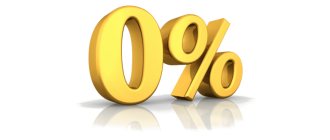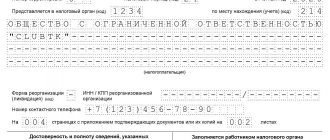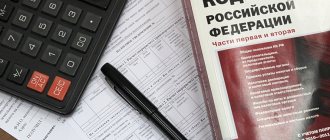Who should pay VAT. Can an individual entrepreneur work with taxes?
This is an indirect tax at the federal level, which involves the withdrawal of part of the added value of a product to the state budget. The final consumer pays the tax amount, since the amount is included in the price. The buyer is the actual payer of this tax.
Enterprises that sell goods or services are considered legal payers. The individual entrepreneur makes the calculations and pays the funds to the state budget. To do this, you need to register with the tax office.
VAT payers:
- Individual entrepreneurs who carry out taxable transactions.
- Organizations carrying out taxable transactions.
- Persons who transport goods across the customs border of the Russian Federation.
VAT is the difference between the proceeds from the sale of goods and the amount paid for raw materials purchased from third parties. Some types of activities, as well as special goods and services, are exempt from VAT in full or in part. The tax amount is collected in advance, without taking into account the fact of sale of the goods.
Pros and cons of working with VAT in 2021
The Tax Code provides the opportunity to choose how to work: pay tax and work on OSNO or choose a simplified system without tax. At first glance, it is easier to refuse to pay additional fees. But entrepreneurs do not always understand how their activities can benefit from this situation.
The absence of a VAT line in an invoice often closes a businessman’s path to profitable deals. Organizations are looking for the same tax payers as partners. This is a problem for small businesses.
Pros of use:
- Large enterprises do not work with contractors who do not pay VAT. Refusal to pay reduces the competitive attractiveness of a business.
- An organization has the right to a tax deduction if it purchased goods/materials from a supplier with VAT included. This is a real saving if the price is favorable compared to suppliers' offers without this tax.
Disadvantages of use:
- The need to carefully verify primary documents and check suppliers.
- Responsibility for maintaining accounting books and tax registers.
- Submission of declarations.
One mistake in calculations leads to large losses. Therefore, the tax authorities more carefully check individual entrepreneurs who pay VAT, in contrast to entities on simplified systems.
Results
Working with VAT increases the attractiveness of the enterprise for larger buyers.
After all, most of them work on OSNO. In addition, when purchasing goods (services) from suppliers with VAT, the tax can be deducted, therefore the cost of the goods may be lower than that of small competitors. At the same time, VAT requires increased responsibility for documents, and also increases the burden on the accountant in terms of maintaining additional tax and accounting registers for VAT accounting. You can find more complete information on the topic in ConsultantPlus. Free trial access to the system for 2 days.
Peculiarities of working as an individual entrepreneur with VAT
An individual entrepreneur must pay VAT if he works under the general taxation system. The payer is obliged to do the following:
- Issue invoices to counterparties.
- Pay tax bills.
- Submit a declaration to the tax office at the place of registration. You can only fill out the title page and the first section.
The allocation of VAT in the invoice should not oblige you to pay this tax. But this may raise questions among inspectors.
If an entrepreneur issues a VAT invoice to a counterparty, he automatically becomes a payer of this tax. If an individual entrepreneur is on the simplified tax system “income minus expenses” and must pay VAT, then this amount can no longer be included in “expenses”. And also with UTII, the amount of tax paid to the supplier is not accepted for deduction.
If an individual entrepreneur works on the simplified tax system, then he is not obliged to pay VAT, and, accordingly, should not issue this type of tax to contractors in the invoice.
Advantages and disadvantages of working with VAT
Like any program, working with VAT has its pros and cons. Let's start with the shortcomings.
It should be noted that value added tax is federal. It is considered one of the most difficult in our country. Not everyone is tempted to pay such a percentage. Moreover, it requires the maintenance of tax and accounting records. This process includes inspections of suppliers, reconciliation of primary documentation in which VAT is registered, preparation and submission of a declaration, as well as verification by the inspectorate. All this takes a lot of time.
It is important to know the scheme according to which the company operates under the simplified tax system. The “income-expenses” model allows suppliers to record the tax received as expenses. It is valid when purchasing a product. Even if a percentage is allocated to the Federation Council. If the “income” formula is chosen, then the tax cannot be deducted. The invoice will not influence this result in any way.
Using OSNO requires thorough checks by the tax service. Its representatives carefully carry out the procedures. This is explained by the fact that the allowance itself contains many controversial issues. If an error or inaccuracy is detected, the inspection has the right to impose penalties in the form of fines. If a simplified system is used, it is impossible to make a mistake, since the internal principle does not allow this.
Everyone faces disadvantages in their work, but there are also advantages to working with VAT.
It’s worth starting with the fact that most large companies and holdings prefer to work with VAT counterparties. As a result, a VAT company does not need to waste time on advertising campaigns to attract potential customers. Such companies occupy the best and most profitable positions in the market, and they receive offers much more often.
The second plus is the reason why such entrepreneurs become more attractive to counterparties. Using this regime, a businessman can deduct tax on all goods and services. This is beneficial, since saving is always important for a company.
After familiarizing yourself with all aspects of this process, each representative of a small or large business will decide for himself whether to work without VAT or with it.
How much to pay and when
In the Russian Federation the rate is 18%. For some types of goods, a reduced rate of 10% is provided: children's goods, food products, agricultural products, printed publications.
The tax period is a quarter. Each quarter has 3 months. The payment amount is set for a quarter and is paid in three equal installments every month, no later than the 25th. For example, for the first quarter of 2018, you must pay in three equal installments by April 25, May and June 2018, respectively.
Table 1 - Tax payment deadlines in 2021
| Period | Until when to pay VAT? |
| IV quarter 2021 | January 25, 2021 February 25, 2021 March 25, 2021 |
| I quarter 2021 | April 25, 2021 May 25, 2021 June 27, 2021 |
| II quarter 2021 | July 25, 2021 August 25, 2021 September 26, 2021 |
| III quarter 2021 | October 25, 2021 November 25, 2021 December 26, 2021 |
The law allows for earlier tax payment, but you must wait until the end of the quarter. For example, for the first quarter of 2021 you can pay 2/3 of the amount or in full from April 1, 2021. Late payment may result in a penalty.
Individual entrepreneurs under special tax regimes who issued an invoice with allocated VAT during the reporting period must pay the tax in a single payment by the 25th of the month following the reporting period. For example, if an individual entrepreneur carried out a corresponding transaction in the first quarter, he is obliged to pay the entire tax amount by April 25, 2019.
The appearance of the tax
The indicator is an evolutionary version of the sales tax that was used several decades ago. His main problem at that time was that the tax was collected on revenue. This caused a lot of problems, including the lack of normal reporting and the initial basis on the same revenue, and not actual profit. For any volume of production and sales, this significantly reduced the net profit for the entrepreneur, who actually worked on self-sufficiency.
Note that value added tax has always been classified as indirect taxes. For them, as a rule, only the fiscal function is applicable, and their appearance is completely provoked by the state’s need to increase the basic budget.
The first adapted and universal version of the VAT has become widespread since 1957. The reason for this was the signing of the EEC Treaty in Rome, the terms of which included mandatory harmonization by all countries of their taxes in order to create a balanced common market. And already in 1967, the tax became an official indirect tax, the introduction of which into each system became mandatory until 1972. The official consolidation of this tax was carried out in 1977, and the last critical adjustments were made in 1991.
It appeared on Russian territory in 1992. This happened immediately after the collapse of the USSR and the tenth directive revised the main provisions on the payment of the indicator.
From January 1, 2021, its value reached 20%.
However, all medical drugs, as well as a number of food items and children's products may be subject to VAT of 10%. In the case of exported goods, there is no indicator as such at all, since its rate is 0%.
Definition on video:
How to calculate the amount to be paid
Option one is to calculate VAT on the amount. Using mathematical calculations, the percentage is calculated using the formula:
VAT = NB * Nst/100, where NB is the tax base or amount excluding tax, Nst is the tax rate of 10% or 20%.
The second option is VAT calculation including. To do this, the amount of tax is allocated from the total amount. If the rate is 20%, then use the following formula:
VAT = C/1.2 * 0.2.
If the tax is 10%, then the procedure is as follows:
VAT = C/1.10 * 0.10.
C is the total amount including tax.
How can a payer pay tax?
Payment goes to the federal budget. It is important to fill out the payment order correctly so that the funds reach the correct account in full.
Sample of filling out a payment order for VAT payment
In field 101 indicate the payer status:
- Organization - 01.
- IP - 09.
- Tax agent - 02.
They also indicate the KBK code, which depends on the type of activity.
On the Federal Tax Service website you can fill out a payment order electronically.
The electronic format of the payment order is identical to the paper version, is filled out step by step, and simplifies the procedure for paying taxes.
Individual entrepreneur reporting
VAT payers submit returns online through an electronic document management operator. Reports to be submitted:
- VAT declaration (once a quarter).
- Declaration 3-NDFL (once a year).
- Declaration 4-NDFL (at the beginning of activity or within a month from the moment of 50% increase or decrease in income).
- Information on the average number of employees (once a year).
- Calculation of 6-NDFL (once a quarter).
- Certificates 2-NDFL (once a year).
- Calculation of insurance premiums.
Table 2 - Deadlines for submitting the declaration
| Period | By what date should the VAT return be submitted? |
| IV quarter 2021 | January 25, 2021 |
| I quarter 2021 | April 25, 2021 |
| II quarter 2021 | July 25, 2021 |
| III quarter 2021 | October 25, 2021 |
If the last day of submission is a non-working day, then the report will be accepted the next day and this will not be considered a violation. If an individual entrepreneur operates without VAT, then the amount of reporting is reduced. Individual entrepreneurs will be required to submit a tax return annually by April 30 of the following year. The individual entrepreneur also keeps a book of income and expenses.
I provided the service without VAT, but the client still highlighted it in the payment order. Will you have to pay?
You won't have to either. The main thing is not to issue an invoice with VAT allocated. If, nevertheless, questions arise from the tax authorities towards the individual entrepreneur, then this is the correct answer: no VAT invoice was issued, so there was no obligation to pay this tax.
And the best thing is to immediately ask the client to correct the error. He will need to send a letter to his bank about the error in the wording of the payment purpose.
Submit reports in three clicks
Elba - online accounting for individual entrepreneurs and LLCs. She will help you issue invoices, generate a VAT return and reporting according to the simplified tax system.
Try 30 days free Gift for new entrepreneurs A year on “Premium” for individual entrepreneurs under 3 months
Tax exemption
Organizations or individual entrepreneurs may be exempt from paying this tax if the amount of their revenue does not exceed established limits. But this rule does not apply to activities related to excisable goods. Individual entrepreneurs and organizations that import goods into the territory of the Russian Federation are also not exempt from paying VAT.
Organizations and individual entrepreneurs have the right to exemption from the performance of taxpayer obligations related to the calculation and payment of tax (hereinafter in this article - exemption), if for the three previous consecutive calendar months the amount of revenue from the sale of goods (work, services) of these organizations or individual entrepreneurs excluding tax did not exceed two million rubles in total.
clause 1, art. 145, Tax Code of the Russian Federation
Persons who have the right to exemption must contact the tax authority at their place of residence with a package of documents:
- Written notice.
- Extract from the sales book.
- Extract from the book of accounting of income and expenses and business transactions.
“Papers” must be provided no later than the 20th day of the current month, otherwise it will not be taken into account in the calculations. The exemption is granted for 12 months. If documents are submitted on time, then the current month will be considered the first in the period. You cannot refuse release. There is no need to wait for a positive response from the tax office. The release is of a notification nature, not a permissive one.
If during the exemption period an individual entrepreneur began to sell excisable goods or the amount of revenue exceeded the established limit (2 million rubles for 3 months), then such an entity loses the right to exemption from paying tax. The reference date is taken to be the 1st day of the month when the specified conditions occur. VAT is also not paid by individual entrepreneurs who operate under a special tax regime: simplified tax system, UTII, unified tax system.
Is it possible to be exempt from paying
The Tax Code allows you to be exempt from paying VAT if financial transactions are carried out within the Russian Federation. These are only special provisions that do not represent the same exemption that is provided to subjects when switching to the simplified tax system.
Those who are exempt from tax:
- not obliged to pay it on the domestic market
- has the right not to submit VAT reports
- ignores maintaining a purchase ledger
- issues invoices to its customers excluding 20% VAT
The use of VAT in business is justified from the point of view of the economy and the formation of the state budget. Moreover, it is an improved version of the income tax that existed in the Russian Federation before it. However, this is still a heavy burden for smaller companies. And often it is this 20% that can significantly reduce the flow of clients.
Top
Write your question in the form below







